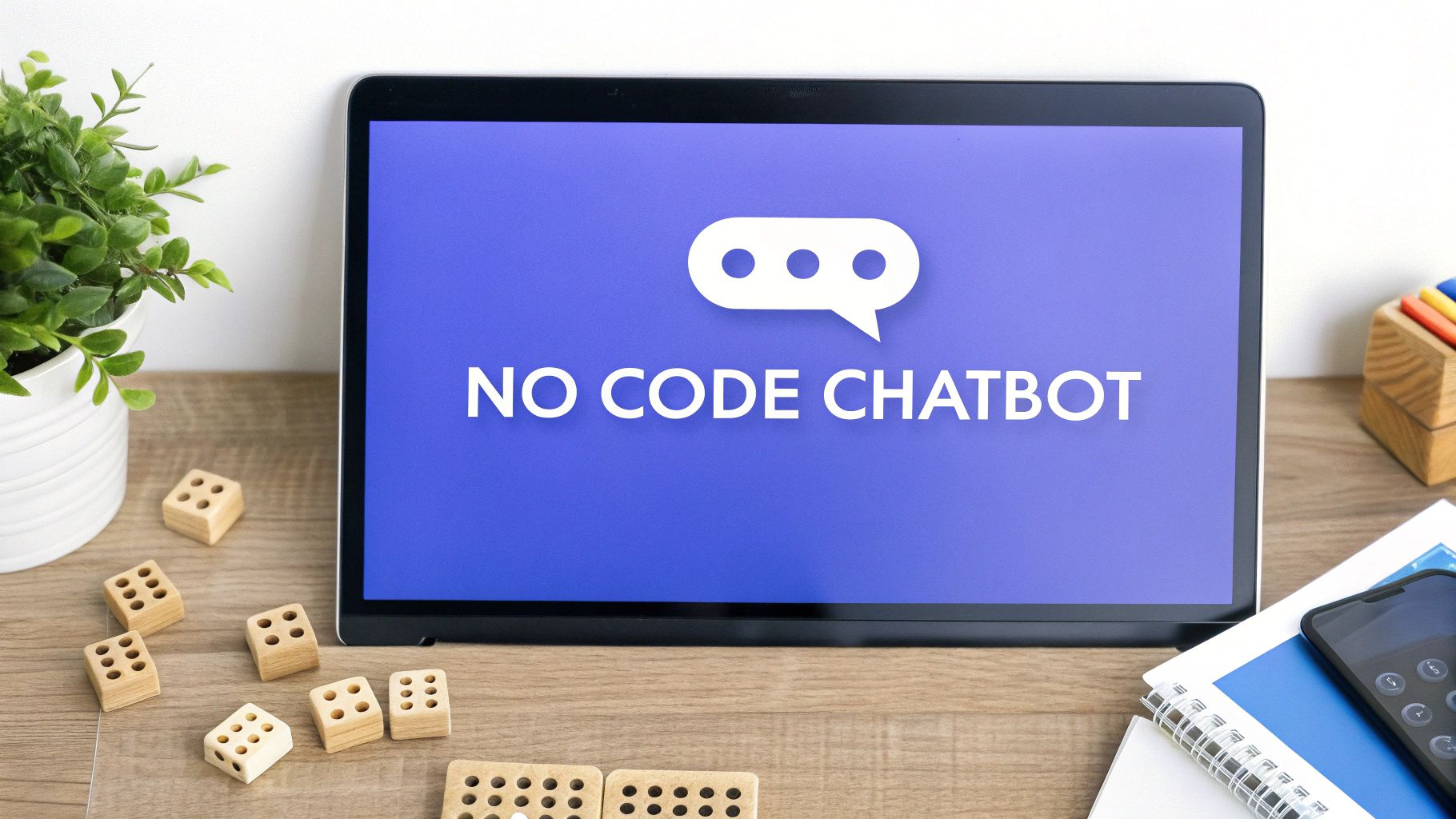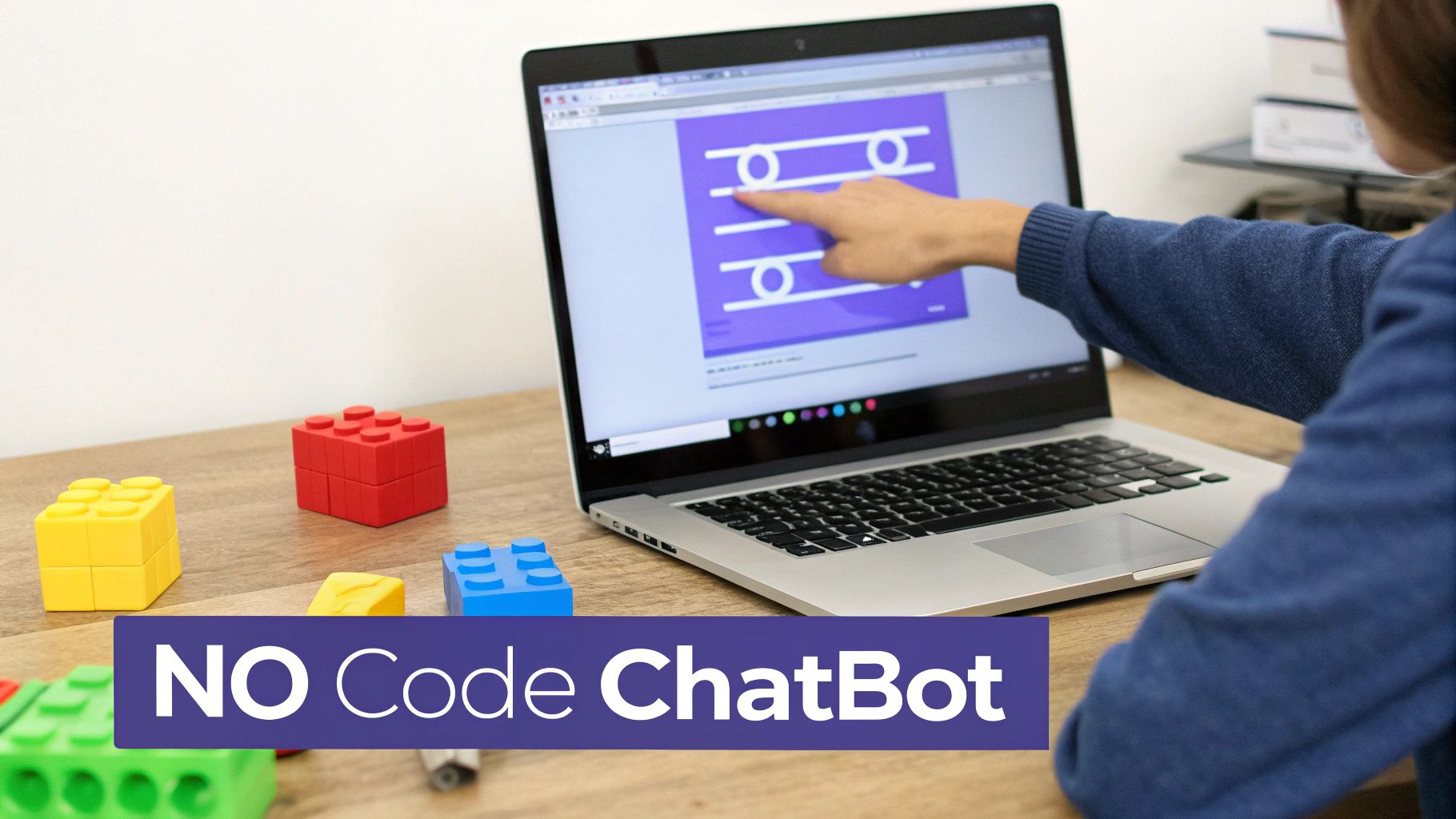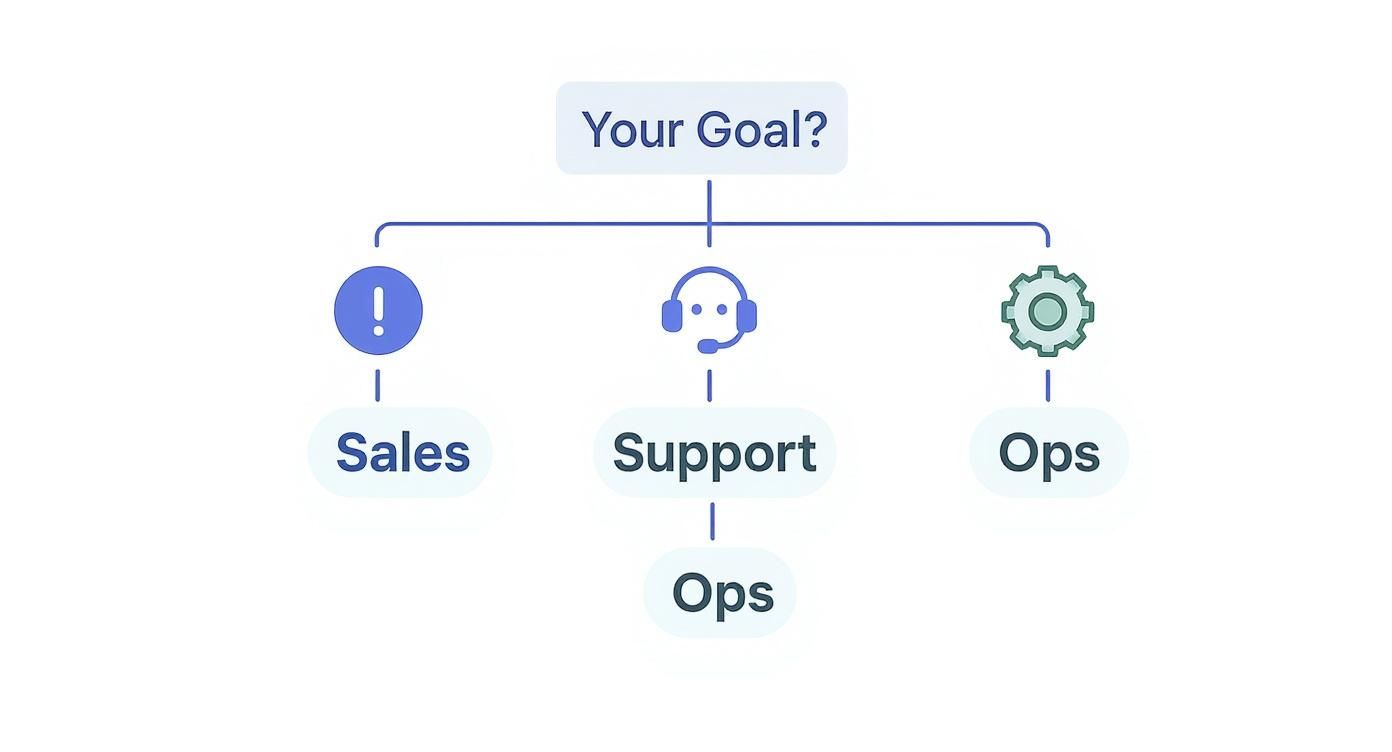Build a Bot with a No Code Chatbot Platform
Discover how a no code chatbot platform empowers you to build powerful bots with no coding. Get practical tips and see real-world use cases.

Think about building something complex, like a car engine. For decades, that was a job only for skilled mechanics who knew how to forge, weld, and assemble every part from scratch.
Now, imagine building that same engine by snapping together pre-made, high-quality blocks, like LEGOs. That’s the simplest way to think about a no code chatbot platform. It’s a tool that lets anyone, and I mean anyone, build a powerful, automated conversational bot using a visual, drag-and-drop interface. No coding required.
This simple shift turns chatbot creation from a specialized, technical job into something any business professional can own.
What a No Code Chatbot Platform Actually Does
At its core, a no code chatbot platform is designed to tear down the technical walls that once stood between an idea and a working chatbot. Instead of writing lines of Python or JavaScript, you work with a visual builder where you can draw out the conversation.

This simple idea has opened doors for businesses of all sizes, from solo entrepreneurs to enterprise marketing teams. The demand for these tools is exploding for a reason. The no-code AI platform market was valued at around USD 3.68 billion recently and is on track to hit an impressive USD 37.96 billion by 2033.
That growth shows a massive shift to tools that let businesses solve their own problems without needing a dedicated development team. You can dig deeper into the no-code AI market growth to see the full picture.
The Power of Visual Building
The heart of any no code chatbot platform is its visual flow builder. It’s a lot like creating a flowchart for a conversation. Each box in the chart might be a message the bot sends, a question it asks, or an action it takes behind the scenes. You connect these boxes with lines to map out every possible conversational path.
For instance, a customer lands on your site and asks about their order. Your visual flow would guide the bot to first ask for an order number. The next block might connect to your Shopify store to check the status, and the final one delivers a real-time update. If the customer’s issue is tricky, the flow can have an escape hatch that transfers them to a live agent.
You design that entire journey just by dragging, dropping, and connecting the dots.
No Code Builder vs Traditional Development
To really get what makes no-code so different, it helps to see it side-by-side with the old way of doing things. Here’s a quick breakdown:
The takeaway is pretty clear: no code puts the power to build, test, and iterate directly into the hands of the people who actually know the customer.
Making Technology Accessible to Everyone
This new approach completely changes who gets to build and manage chatbots. It’s no longer a job siloed within the IT or development department.
- Marketing Teams can spin up a bot in an afternoon to capture leads from a new ad campaign.
- Sales Teams can build their own bot to qualify website visitors and book demos 24/7, even while they sleep.
- Support Staff can design automated flows to handle the top 80% of repetitive questions, freeing themselves up for the tough cases.
By putting the tools directly into the hands of the people who know customer conversations best, businesses can create more effective and relevant chatbots. This direct control allows for rapid updates and adjustments without needing to go through a development cycle, making the whole process faster and more agile.
The Core Benefits of No-Code Chatbots
Switching to a no-code chatbot platform is about more than just adding another tool to your stack. It’s a fundamental shift in how you talk to customers and run your internal operations. The upsides go beyond just automating a few conversations, they lead to real business results like faster launches, lower overhead, and teams that are happier and more productive.
The most immediate win is speed. Forget about development projects that drag on for months. With a no-code tool, you can design and deploy a working chatbot in a few hours. That kind of agility lets you react to business needs on the fly. For instance, an e-commerce store gearing up for a holiday sale can build a bot in an afternoon to handle the flood of questions about order tracking and returns.
Drive Down Costs and Free Up Your Team
Another huge advantage is the cost savings. Building a chatbot from scratch means hiring specialized developers, and that’s a major expense. A no-code platform swaps that unpredictable cost for a straightforward monthly subscription, making powerful automation accessible even for smaller businesses.
This isn't just about saving money on salaries. It's about getting back your team's most valuable resource: their time. Because these platforms are so good at streamlining repetitive tasks, they've become powerful workflow automation tools. When a bot is busy answering the same questions over and over, your support agents are free to tackle the complex, high-stakes customer issues that actually require a human touch.
Chatbot technology has come a long way from the rigid, scripted bots of the past. Today's AI-powered conversational agents allow businesses to offer personalized support at a massive scale. In fact, when chatbots take over routine tasks, up to 64% of customer service agents can spend more of their time solving tricky problems, leading to better outcomes and higher job satisfaction.
Scale and Adapt with Ease
Business needs are always changing, and your tools should be able to keep up without causing a massive headache. No-code platforms are designed to scale right with you. As your company grows or your customer needs shift, you can tweak your chatbot’s conversation flows in minutes.
Think about these common growth scenarios:
- Launching a New Product: You can update your bot in minutes to field questions about new features, pricing, and availability.
- Expanding to a New Market: It’s simple to clone an existing chatbot and adjust its language and tone for a completely different audience.
- Changing a Business Process: If your return policy gets an update, you can change the bot's script with a few clicks, making sure every customer gets the right information instantly.
This kind of flexibility means your chatbot grows with your business instead of holding it back. You can constantly refine its performance based on real analytics and customer feedback, all without ever writing a single line of code. This keeps your automated assistant relevant and valuable for the long haul.
Key Features to Look for in a No Code Platform
Choosing the right no-code chatbot platform can feel like a big decision, but it gets a whole lot easier once you know what to look for. Not all platforms are built the same, and the best ones share a few core features that make building and managing your bot simple and effective. These are the non-negotiables that separate a great tool from a frustrating one.
The single most important feature is a visual drag-and-drop flow builder. Think of this as your canvas. It lets you map out conversations visually, connecting questions, answers, and actions just like you would on a whiteboard. This intuitive approach means you can design complex interactions without any technical background at all.

Essential Building Blocks and Shortcuts
A good platform won't make you start from scratch every time. Look for pre-built templates for common tasks. These are ready-to-use conversation flows for things like lead generation, customer support FAQs, or booking appointments.
Templates give you a massive head start. You can launch a functional bot in minutes and then tweak it to fit your specific brand voice and business rules. This feature alone can cut your setup time from days down to just a few hours.
Another critical piece is how well the platform plays with other tools. Your chatbot shouldn't operate in a silo. Native integration capabilities are key for connecting your bot to the software you already use, like your CRM, email marketing service, or internal chat apps like Slack. This turns your bot into a central hub for automation, not just another standalone gadget.
Analytics for Continuous Improvement
Finally, you can't improve what you don't measure. A robust analytics dashboard is an absolute must-have. This is where you get the insights needed to make your chatbot smarter and more helpful over time.
Good analytics do more than just count conversations. They show you exactly where users get stuck or drop off, helping you pinpoint confusing parts of your script. Fixing these weak spots directly improves your bot's performance and the user's experience.
A strong analytics suite should track a few key metrics to give you a clear view of your bot's effectiveness.
- Conversation Volume: See how many people are interacting with your bot and identify peak times.
- User Satisfaction: Collect direct feedback to see how helpful your bot actually is.
- Goal Completion Rate: Track how often the bot successfully completes its main task, like capturing a lead or answering a question.
- Human Handoff Rate: Monitor how frequently conversations need to be escalated to a live agent.
By keeping an eye on these numbers, you can make data-driven decisions to fine-tune your chatbot's performance. If you want to dig deeper, you can find more detail in our guide on the right analytics for chatbots. This data-first approach makes sure your bot continues to deliver value long after its initial launch.
Integrating Your Chatbot with Business Tools
A chatbot is a powerful tool on its own, but its real magic happens when it stops being an isolated gadget and starts talking to the other software that runs your business.
Think of it like hiring a new team member. They're much more effective once they have access to the company’s CRM, project boards, and internal chat. Integrations give your chatbot that same level of access, turning it from a simple Q&A machine into a central hub that automates entire workflows.
And with a modern no-code chatbot platform, you don't need a developer to make these connections happen. You can often link your most important tools with just a few clicks.

Connecting to Your CRM
One of the most valuable connections you can make is with your Customer Relationship Management (CRM) system. When a chatbot is hooked into your CRM, it can perform tasks that directly grow your sales pipeline.
For instance, a chatbot on your website can qualify a new lead by asking a few quick screening questions. Once it gathers the right info, the integration lets it automatically create a new contact in your CRM, assign it to the right sales rep, and even log the full conversation history.
This all happens instantly, 24/7, without a single second of manual data entry from your team. If you want to see this in action, you can check out our guide on setting up a chatbot for Salesforce.
Streamlining Internal Communication
Integrations aren't just for customer-facing tasks. Connecting your chatbot to internal communication tools like Slack or Google Chat can seriously boost your team's efficiency.
Imagine a high-value prospect is on your website and asks a complex question the bot can't answer. Instead of leaving them hanging, the bot can fire off an instant notification to a specific Slack channel. This alert can include the user's question and a link to the live chat, allowing a human agent to jump in immediately and save the deal.
By connecting your chatbot to internal messaging apps, you create a seamless bridge between automated support and human expertise. This makes sure that no important query ever falls through the cracks, improving both the customer experience and your team's response time.
Embedding on Your Website
Finally, the most fundamental integration is with your website itself. A good no-code chatbot platform should make it incredibly easy to add your bot to any site, no matter what it's built on.
Popular platforms offer simple plugins or copy-paste code snippets for systems like:
- WordPress: Add a chatbot to your blog or business site to engage readers and answer their questions on the spot.
- Webflow: Seamlessly embed a bot into your custom-designed site to capture leads or provide instant support.
- Shopify: Use a bot to help shoppers with order tracking, product recommendations, and checkout questions, reducing cart abandonment.
This ease of integration means your chatbot becomes a natural part of your online presence, ready to help visitors wherever they find you.
How Different Teams Use Chatbots in the Real World
The real power of a no-code chatbot platform clicks into place when you see how it solves everyday problems for different teams. This isn't a one-trick pony; it's a flexible tool that molds itself to the unique headaches of your sales, support, and operations crews.
By looking at how these bots work in the wild, you start to see them shift from a "nice-to-have" gadget to a core part of a team's daily workflow. This is why the market is moving so fast. Forecasts show that nearly 70% of new business apps, including chatbots, will soon be built on low-code or no-code platforms. You can look deeper into the latest research on the no-code AI platform market.
This change is happening for one simple reason: the practical benefits are impossible to ignore.
How Sales Teams Can Win More Leads
For a sales team, a chatbot is like having a tireless assistant who works 24/7. Instead of watching valuable website visitors wander off after hours, a bot can engage them on the spot.
A sales-focused chatbot can:
- Qualify Leads Around the Clock: The bot asks smart screening questions, like company size, role, or budget, to figure out who the serious prospects are.
- Book Demos Automatically: It hooks directly into a sales rep's calendar to schedule meetings, killing the endless email back-and-forth that stalls momentum.
- Route Hot Leads Instantly: When a high-value prospect pops up, the bot can ping the right salesperson on Slack or via email for immediate follow-up.
This kind of automation keeps the sales pipeline full and lets reps focus their energy on what they do best: closing deals.
Lightening the Load for Customer Support
In customer support, the name of the game is resolving issues quickly and accurately. A no-code chatbot is a game-changer for deflecting the flood of repetitive questions that can drown a support team.
The bot becomes the first line of defense, serving up instant answers to common queries like "Where is my order?" or "How do I reset my password?" This immediately cuts down on ticket volume, freeing up human agents to tackle the complex, sensitive customer issues that really need a personal touch.
Chatbots are also great for putting actionable SaaS onboarding best practices into motion, guiding new users through setup and answering their questions in real time.
Streamlining Internal Operations
But chatbots aren't just for talking to customers. They're also incredibly useful for smoothing out internal processes and supporting your own employees. Think of an internal bot as a central, always-on resource for the whole company.
An operations-focused chatbot can live inside a company-wide Google Chat or Slack channel. It can field common HR questions about paid time off, benefits, or company policies. It can also handle basic IT support requests, walking employees through troubleshooting steps before ever creating a ticket.
This kind of internal automation saves everyone a ton of time. Employees get instant answers without tapping a colleague on the shoulder, and operations teams spend less time on routine administrative tasks.
Chatbot Applications by Department
To put it all together, here’s a quick summary of how different departments can put a no-code chatbot to work.
As you can see, the applications are broad. A single no-code chatbot platform can serve multiple teams, making it a surprisingly high-impact investment for the whole organization.
How to Choose the Right No Code Chatbot Platform
With so many no-code chatbot platforms out there, it’s easy to get lost in a sea of options. My advice? Forget the flashy features for a minute and ask one simple question: What am I actually trying to accomplish?
Are you looking to generate more qualified leads for your sales team? Or is your main goal to slash the number of support tickets hitting your inbox?
Your answer is your compass. It guides every other decision you’ll make. A sales-focused bot needs to hook directly into your CRM, while a support bot is useless if it can’t tap into a knowledge base. Once you’re crystal clear on that goal, you can start to build a real evaluation framework.

This decision tree helps visualize how your core business goal should point you toward the right kind of chatbot strategy, whether it’s for sales, support, or operations.
Key Criteria for Your Shortlist
Now that you have your goal in mind, you can start comparing platforms with a few key criteria. This keeps you focused on the factors that truly matter for your business.
Ease of Use: How intuitive is the visual builder, really? The entire point of a no code chatbot platform is to get you building without technical headaches. If the interface feels clunky or confusing, it completely defeats the purpose.
Integration Options: Does it play well with the tools your team already relies on? Look for native connections to your CRM, internal chat tools like Slack or Google Chat, and your website platform. For a deeper look at what’s possible, check out our guide on building with a no code AI agent builder.
Pricing Models: You need to get a handle on how you’ll be charged. Is it per conversation, per user, or a flat monthly fee? Make sure the pricing model fits your expected usage and won’t break the bank as you start to grow.
Honestly, the best way to make a final call is to just try your top choices out. Nearly every platform offers a free trial. Use it. Build a small, simple bot that tackles your main goal. That hands-on experience will tell you more than any feature list ever could, revealing if a platform is genuinely a good fit for you and your team.
Your Top No Code Chatbot Questions, Answered
If you're just starting to explore no code chatbot platforms, you probably have a few questions. Here are some of the most common ones we hear, with straight-to-the-point answers.
Do I Need Any Technical Skills?
Nope, not at all. These platforms were built from the ground up for people who don't code.
Most use a visual, drag-and-drop interface that feels more like putting together a flowchart than writing script. If you're comfortable with standard office software, you have everything it takes to build a fully functional chatbot.
How Long Does It Take To Build a Chatbot?
This is where no-code really shines. You can get a simple bot up and running in just a few hours, perfect for handling common questions or routing basic inquiries.
For a more advanced chatbot with several integrations, you might spend a day or two getting everything set up and tested just right. Compare that to traditional development, which can easily stretch into weeks or even months.
Can a No Code Chatbot Handle Complex Conversations?
Absolutely. Modern no-code platforms aren't just simple "if-then" machines anymore. They often come packed with advanced AI and Natural Language Processing (NLP).
This tech allows the bot to understand what a user actually means, not just the keywords they type. You can also design intelligent conversation flows that know exactly when to hand a chat over to a human agent if things get too complex.
How Much Does a No Code Chatbot Platform Cost?
Pricing can vary quite a bit, so it depends on what you need. Most platforms run on a monthly subscription model, often based on things like how many chatbots you need or your monthly conversation volume.
The good news is that many offer a free tier or a trial period. This lets you get your hands dirty and test out the platform to see if it's the right fit before you commit to anything.
Ready to see how a no-code chatbot can work for your business? With Chatiant, you can build a custom AI agent trained on your own data in minutes. Start building your intelligent chatbot today.


